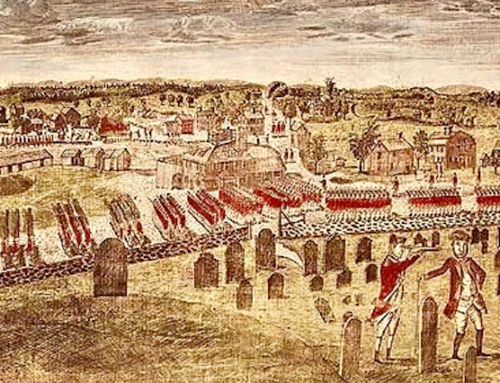In the name of God, amen. We whose names are under written… [h]aving undertaken for the Glory of God, and advancement of the christian [sic] faith, and the honour of our King and country, a voyage to plant the first colony in the northern parts of Virginia; do by these presents solemnly and mutually, in the presence of God and one another, covenant and combine ourselves together into a civil body politick, for our better ordering and preservation, and furtherance of the ends aforesaid: And by virtue hereof, do enact, constitute and frame such just and equal laws, ordinances, acts, constitutions and officers, from time to time, as shall be thought most meet and convenient for the general good of the colony.
 Thus pledged 41 men on board the ship Mayflower that day, November 11, 1620, having survived a rough 64-day sea voyage, and facing an even more grueling winter and a “great sickness” like what had ravaged the Jamestown colony in Virginia. These Pilgrim Fathers had sailed to the New World with their families from exile in Leyden, Holland, with a stop in England to secure consent from the Virginia Company to settle on the latter’s territory. They were delayed by various exigencies from leaving England until the fall of 1620. The patent from the Company permitted the Pilgrims to establish a “plantation” near the mouth of today’s Hudson River, at the northern boundary of the Company’s own grant.
Thus pledged 41 men on board the ship Mayflower that day, November 11, 1620, having survived a rough 64-day sea voyage, and facing an even more grueling winter and a “great sickness” like what had ravaged the Jamestown colony in Virginia. These Pilgrim Fathers had sailed to the New World with their families from exile in Leyden, Holland, with a stop in England to secure consent from the Virginia Company to settle on the latter’s territory. They were delayed by various exigencies from leaving England until the fall of 1620. The patent from the Company permitted the Pilgrims to establish a “plantation” near the mouth of today’s Hudson River, at the northern boundary of the Company’s own grant.
For whatever reason, either a major storm, as the Pilgrims claimed, or intent to avoid the reach of English creditors’ claims on indentured servants, as some historians allege, the ship ended up at Cape Cod on November 9. Bad weather and the precarious state of the passengers made further travel chancy, and the Pilgrim leaders decided to find a nearby place for settlement. Cape Cod was deemed unsuitable for human habitation. Instead, the Pilgrims disembarked on December 16 at Plymouth, so named earlier by Captain John Smith of the Virginia Company during one of his explorations. Since they were now a couple of hundred miles outside the Virginia Company’s territory, their patent was worthless. It became necessary to establish a new binding basis for government of their society.
The result was the Mayflower Compact, infused with a remarkable confluence of religious and political theory. The Pilgrims, like the Puritans who settled Massachusetts Bay in 1630, were dissenters from the Church of England. The former opted to separate themselves from what they perceived as the corruption of the Church of England, whereas the less radical nonconformists, the Puritans, sought to reform that church from within. Both groups, however, found the political and religious climate under the Stuart monarchs to be unfriendly to dissenters.
As common historical understanding has it, both groups sought to escape to the New World to practice their religion freely. However, that meant their religion. They set out to establish their vision of the City of God in an earthly commonwealth. As the Compact stated, their move was “undertaken for the Glory of God, and advancement of the christian faith.” Neither group set out to establish a classically liberal secular society tolerant of diverse faiths or even a commonwealth akin to the Dutch Republic, with an established church, yet accepting of religious dissent. The corrosive effect of such dissent would have been particularly dangerous to the survival of the small Pilgrim community clinging precariously to their isolated new home in Plymouth. Indeed, once the colony became established and became focused on commerce and trade, more devout members disturbed by this turn to the material left to form new communities of believers.
The religious orientation of the Mayflower Compact grew out of the Pilgrims’ Calvinist faith. In contrast to the Roman Catholic Church and its successor establishment in the Church of England, Calvinists rejected centralized authority with its dogmas and traditions as having erected impious barriers and distractions to a personal relationship with God. Instead, the congregation of like-minded believers gathered in community. It was a community founded on consent of the participants and given meaning by their shared religious belief. Those who rejected significant aspects of that belief would leave (or be shunned).
In Europe, those religious communities operated within—and chafed under—hostile existing political orders, most of which still were organized on principles other than consent of the participants. Once transplanted across the Atlantic Ocean, the Pilgrims were free of such restraints and could organize their religious life together with their political commonwealth within the Calvinist congregational framework. Their brethren, the Puritans of Massachusetts Bay, established their colony on the same type of religious foundation, as did a number of later communities that spread from the original settlements. The successor to the Puritans and Pilgrims was the Congregational Church, organized along those communitarian lines based on consent. That church became the de facto established church of Massachusetts Bay Colony and the state of Massachusetts under a system of state tax support, a practice that survived until 1833.
On the political side, the Mayflower Compact was one of three types of constitutions among the colonies in British North America. The others were the joint stock company or corporation model of the Virginia Company and the Massachusetts Bay Company, and the proprietary grant model, the dominant 17th-century form used for the remaining colonies, such as the grant to Lord Calvert for Maryland and William Penn for Pennsylvania. Of the three, the Mayflower Compact most profoundly and explicitly rested on the consent of the governed. It provided the model for other early American “constitutions” in New England, such as the 1636 compact among Roger Williams and his followers in founding Providence, Rhode Island, the compacts among settlers that similarly established Newport and Portsmouth in Rhode Island and the New Haven Colony in 1639, and, most significantly, the Fundamental Orders of Connecticut. The Orders, in 1639, united the Connecticut River Valley towns of Hartford, Windsor, and Wethersfield and provided a formal frame of government. Like the Mayflower Compact, the Orders rested on the consent of the people to join in community, but in their structure they closely resembled the Massachusetts Bay Company agreement.
The political analogue to the congregational organization of the Calvinist denominations was the “social compact” theory, an ethical basis for the state that also rested on the consent of the governed. Classical Greek theory had held that the polis represented a progression of human association beyond family and clan and evolved as the consummate means conducive to human flourishing. In its medieval scholastic version epitomized by the writings of Thomas Aquinas, the state was ordained by God to provide for the welfare and happiness of its people within an ordered universe governed by God’s law. By contrast, the social compact theory rested on the will of the individuals that came together to found the commonwealth. It was a rejection of the static universal political (and religious) order that had governed Western Christendom and in which one’s status and privileges depended on one’s place in that order. After the Reformation, Protestant sects had many, sometimes conflicting, assumptions about the nature and the specifics of the relationship between the believer and God. In similar manner, social compact theory was not a unified doctrine, but varied widely in its details of the relationship between the individual and the state, depending on the particular proponent.
The two social compact theorists with the greatest influence on Americans of the Revolutionary Era were Thomas Hobbes and John Locke, with the latter’s postulates the more evident among American essayists and political leaders. Locke’s reflections on religion and politics were greatly influenced by the Puritanism of his upbringing. Although the governments established under the various state constitutions, as well as those created through the Articles of Confederation and the Constitution of 1787, more closely resembled the corporate structures of the colonial joint stock company arrangements, they were formed through the direct or indirect consent of the governed. The Constitution of 1787, for example, very conspicuously required that no state would become a member of the broader “united” community without its consent. In turn, such consent had to be obtained through the most “explicit and authentic act” of the state’s people practicable under the circumstances, that is, through a state convention.
To whatever concrete extent the Mayflower Compact’s foundation on consent may have found its way into the organizing of American governments during the latter part of the 18th century, it is the Declaration of Independence that most clearly incorporates the compact’s essence. The influence of Locke and his expositors on Thomas Jefferson’s text has been analyzed long and frequently. But it is worth noting some of the language itself. The Declaration asserted that Americans were no longer connected in any bond (that is, any obligation) to the people of Britain, just as the Pilgrims, having sailed to a wilderness not under the control of the Virginia Company, believed that they were not bound by the obligations of the patent they had received. The Americans would establish a government based on the “consent of the governed,” “laying its foundation on such principles and organizing its powers in such form, as to them shall seem most likely to effect their Safety and Happiness,” just as the signatories of the Mayflower Compact had pledged.
So it came about that a brief pledge, signed by 41 men aboard a cramped vessel in 1620, “with no friends to welcome them, no inns to entertain or refresh them, no houses, or much less towns to repair unto to seek for succour,” with “a mighty ocean which they had passed… and now separate[d] them from all the civil parts of the world” behind them, and with “a hideous and desolate wilderness, full of wilde beasts and wilde men” in front of them, deeply affected the creation of the revolutionary political commonwealth founded in the New World a century and a half later.
Republished with gracious permission from Constituting America.
The Imaginative Conservative applies the principle of appreciation to the discussion of culture and politics—we approach dialogue with magnanimity rather than with mere civility. Will you help us remain a refreshing oasis in the increasingly contentious arena of modern discourse? Please consider donating now.
The featured image is a mural at the U.S. Capitol by Allyn Cox (1973-1974): The Mayflower Compact, a document signed aboard the ship Mayflower in 1620, set forth principles of tolerance and liberty for the government of a new colony in the New World. Pilgrim leader William Brewster is shown signing the document; John Standish, the colony’s military leader, stands at left. This file is in the public domain, courtesy of Wikimedia Commons.







Leave A Comment